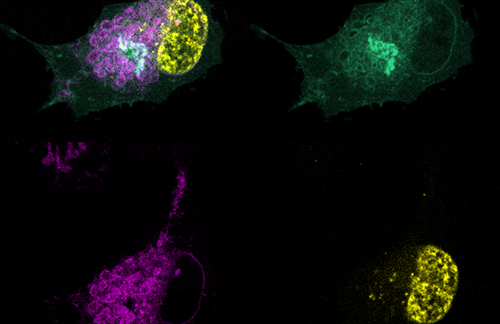In Nature, Sebastian Doll from Marcus Conrad’s group at Helmholtz Center Munich and the group of José Pedro Friedmann Angel at University Würzburg, Germany, describe a new factor protecting cancer cells against ferroptosis, an iron-dependent form of necrotic cell death marked by oxidative damage to the cell membrane’s phospholipids. So far, ferroptosis induction has been believed to be restrained only by the glutathione peroxidase 4 (GPX4), which reduces phospholipid hydroperoxide (PLOOH) in the cell membrane, and radical-trapping antioxidants (RTAs). However, as induction of ferroptosis by GPX4 inhibitors has emerged as a therapeutic strategy to trigger cancer cell death, Doll et al. undertook an expression cloning approach to identify additional factors mediating ferroptosis resistance that are able to fully complement GPX4 loss in treatment-resistant breast cancer cells.
They found a previously unrecognised anti-ferroptotic gene, AIFM2 (apoptosis inducing factor mitochondria-associated 2) to confer an unprecedented protection against ferroptosis in hundreds of cancer cell lines. Further experiments revealed that ferroptosis suppression by AIFM2 is mediated by ubichinol – the reduced form of ubiquinone (CoQ10), which traps lipid peroxyl radicals that mediate lipid peroxidation in the cell membrane, while FSP1 catalyses its regeneration by using NAD(P)H. Pharmacological targeting of AIFM2 (which Doll et al. renamed FSP1) strongly synergised with GPX4 inhibitors to trigger ferroptosis in cancer entities. Specifically, the level of resistance to ferroptosis across many human cancer cell lines in vitro correlated with the amount of FSP1 present in the cells. Furthermore, Doll et al. found that FSP1 mediated resistance to ferroptosis in lung cancer cells in culture and in mouse tumour xenografts.
As compounds that induce ferroptosis are already known, Doll et al. want to sensitise cancer cells against them using FSP1 inhibitors. They have just identified and validated a compound from a phenotypic screening of 10,000 compounds. According to group leader Marcus Conrad, the way forward is to screen for new inducers of ferroptosis, to utilise FSP1/AIFM2 as a biomarker for future therapies that target ferroptosis and to further validate the role of ubichinol as FSP1/AIFM2 blocker used by therapy-resistant cancer cells undergoing epithelial-mesenchymal transition.



 Orano Med SA
Orano Med SA fvm.dk
fvm.dk Office of Congresswoman Ayanna Pressley - https://pressley.house.gov/press-kit/
Office of Congresswoman Ayanna Pressley - https://pressley.house.gov/press-kit/